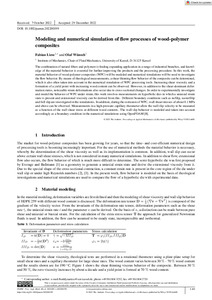| dc.date.accessioned | 2023-07-31T15:11:33Z | |
| dc.date.available | 2023-07-31T15:11:33Z | |
| dc.date.issued | 2023-05-31 | |
| dc.identifier | doi:10.17170/kobra-202307218450 | |
| dc.identifier.uri | http://hdl.handle.net/123456789/14956 | |
| dc.description.sponsorship | Gefördert im Rahmen des Projekts DEAL | ger |
| dc.language.iso | eng | |
| dc.rights | Attribution-NonCommercial-NoDerivatives 4.0 International | * |
| dc.rights.uri | http://creativecommons.org/licenses/by-nc-nd/4.0/ | * |
| dc.subject.ddc | 660 | |
| dc.title | Modeling and numerical simulation of flow processes of wood-polymer composites | eng |
| dc.type | Aufsatz | |
| dcterms.abstract | The combination of natural fibers and polymers is finding expanding application in a range of industrial branches, and knowledge of the material behavior is essential for further improving the products and the processing procedure. In this work, the material behavior of wood-polymer composites (WPC) will be modeled and numerical simulations will be used to investigate the flow behavior. By means of rheological measurements, a shear thinning flow behavior of the composite can be determined, which is also often taken into account in the numerical simulation of WPC processing tools. Increasing shear viscosity and a formation of a yield point with increasing wood content can be observed. However, in addition to the shear-dominant deformation states, noticeable strain deformations also occur due to cross-sectional changes. In order to experimentally investigate and model the behavior of WPC under strain, this work involves measurements on hyperbolic dies in which a uniaxial strain state is present and extensional viscosity can be derived from this. Different boundary conditions such as noSlip, navierSlip and full slip are investigated in the simulations. In addition, during the extrusion of WPC, wall shear stresses of about 0.1 MPa and above can be observed. Measurements in a high-pressure capillary rheometer allow the wall slip velocity to be measured as a function of the wall shear stress at different wood contents. The wall slip behavior is modeled and taken into account accordingly as a boundary condition in the numerical simulations using OpenFOAM [8]. | eng |
| dcterms.accessRights | open access | |
| dcterms.creator | Liese, Fabian | |
| dcterms.creator | Wünsch, Olaf | |
| dc.relation.doi | doi:10.1002/pamm.202200199 | |
| dc.subject.swd | Wood-Plastic-Composite | ger |
| dc.subject.swd | Fließverhalten | ger |
| dc.subject.swd | Stoffeigenschaft | ger |
| dc.subject.swd | Numerische Strömungssimulation | ger |
| dc.type.version | publishedVersion | |
| dcterms.source.identifier | eissn:1617-7061 | |
| dcterms.source.issue | Issue 1 | |
| dcterms.source.journal | Proceedings in Applied Mathematics and Mechanics (PAMM) | eng |
| dcterms.source.volume | Volume 23 | |
| kup.iskup | false | |
| dcterms.source.articlenumber | e202200199 | |


